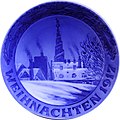Royal Copenhagen
| Royal Copenhagen
|
|
|---|---|
| legal form | |
| founding | May 1, 1775 |
| Seat | Copenhagen |
| Branch | Hardware and hardware wholesale |
| Website | www.royalcopenhagen.com |


Royal Copenhagen , German also Königlich Copenhagen , is the brand of the Royal Porcelain Manufactory in Copenhagen (Danish Den kongelige Porcelænsfabrik ). The company has been part of the Finnish Fiskars group since 2012 . The porcelain painting was in 2013 after Thailand moved, only the famous service Flora Danica is still made in Denmark.
history
The manufacture was founded on May 1, 1775 by the pharmacist and arcanist Frantz Heinrich Müller (1732–1820) in Copenhagen and managed until 1801. Frantz Heinrich Müller obtained the necessary raw material from the pharmacist Marc-Hilaire Vilaris (1719–1792) in Bordeaux , who discovered corresponding kaolin deposits near Saint-Yrieux in the Limousin in 1766 . The young company was initially funded by the state with the promise of a monopoly for 50 years. The patronage took over the Queen Dowager Juliane Marie . As early as 1779, however, financial involvement of the royal family in the manufacture became necessary, which then became state property.
Almost a century later, privatization took place in 1868 and the Royal Porcelain Manufactory got private partners again. In 1882, the aluminia faience factory acquired all of the shares and relocated production to Frederiksberg just outside the city. Aluminia faiences were produced under this name until 1969, when they have been marketed as Royal Copenhagen faience .
Due to the coalition wars and the continental blockade , production came to a standstill between 1806/07 and 1816. During the Danish National Romanticism made himself Gustav Friedrich Hetsch , architect and artistic director of the factory from 1828 to 1864, the Empire forms deserves the porcelain. After that, the artistic direction was in the hands of the painter Heinrich Hansen , who stands for the Nordic Neo-Renaissance. Hansen created a series of table utensils with views of the royal palaces, and in 1873 he took part in the world exhibition in Vienna with a giant vase , which he had painted inside with a view of St. Peter's Basilica in Rome. In the period from 1884 to 1916, the architect Arnold Krog (1856–1931) pioneered the design.
As part of an expansion strategy in the luxury goods segment, Royal Copenhagen acquired the Danish silver manufacturer Georg Jensen (1972) and merged with the glass manufacturer Holmegaard (1985) and the competitor Bing & Grøndahl (1987) founded in 1853 . The resulting Royal Scandinavia group was bought by the investment company Axcel in 2001 . In 2012 the fund passed on its stake to the Finnish group Fiskars . The glass manufacturer Holmegaard was sold to the management as part of a buyout and then went bankrupt. The Rosendahl Design Group took over the brand and production .
Products
The most important product is the “Flora Danica” dinner service , which is still used today by the Danish royal family on festive occasions.
One of the classics is also blue painting , partly on fluted porcelain, Danish Blue Fluted (literally painted shell ), pattern no.1 . It is also offered with playfully oversized motifs; At times it was also available in black, orange and turquoise.
Around 1900 Fanny Gardes seagull service became popular, the underglaze painting of which attracted a lot of attention. With the takeover of Bing & Grøndahl, it has become part of the traditional inventory of Royal Copenhagen.
Travel souvenir, Christmas, New Year and Mother's Day plates have a long tradition as gifts and collectibles.
Manufactory brand
The bottom mark shows three wavy lines that symbolize the three straits of Denmark: the Great Belt , the Little Belt and the Øresund .
See also
Web links
- Royal Copenhagen (English)
Remarks
- ↑ Ditte Jensen: Farvel til solidariteten information.dk, February 22, 2014.
- ↑ Franz Heinrich Müller . In: Hans Vollmer (Hrsg.): General lexicon of fine artists from antiquity to the present . Founded by Ulrich Thieme and Felix Becker . tape 25 : Moehring – Olivié . EA Seemann, Leipzig 1931, p. 225 . "Produced Denmark's first hard-paste porcelain in 1763."
- ↑ Her eldest brother, Duke Karl (1713-80) founded the Fürstenberg porcelain factory on the Weser .
- ↑ After Heinrich Hansen . In: Hans Vollmer (Hrsg.): General lexicon of fine artists from antiquity to the present . Founded by Ulrich Thieme and Felix Becker . tape 16 : Hansen – Heubach . EA Seemann, Leipzig 1923, p. 6 .
- ↑ Company overview of Axcel holdings Axcel and press release Royal Copenhagen Axcel sells Royal Copenhagen ( Memento of the original from March 16, 2014 in the Internet Archive ) Info: The archive link has been inserted automatically and has not yet been checked. Please check the original and archive link according to the instructions and then remove this notice. , December 12, 2012
- ↑ Sample - Royal Copenhagen , accessed September 6, 2019
- ↑ Lars Hedebo Olsen: I 2015 bliver farver det nye sort i boligen Politiken online, January 7, 2015 (Danish).








